Performance
At 3000 lux, the image is decent. The fine detail is lacking, to be sure. The resolution score (below) confirmed this – the pixel count is simply not there on the sensor. This is typically the case for camcorders in this price range, but exceptions can be found. The color performance, however, was not too bad. Unlike so many consumer camcorders, the GZ-MG130 did not super-saturate the colors. True, the reds are hot, and the greens tends to run together, but overall, they don’t sear the eyeballs quite as much as we anticipated. Don’t get us wrong, these are more saturated than broadcast standard – just a little better than the competition. Overall, the image has a soft, washed look, like an unsharp mask has been added.
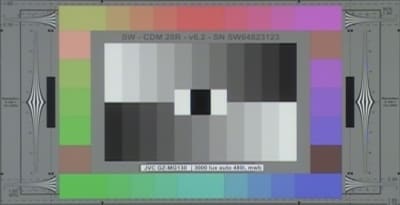
Compared to this year’s Hitachi DZ-HS300A, a hybrid HDD/DVD camcorder, the image was much better. The Hitachi picture displayed inferior resolution and oversaturated colors. The Panasonic VDR-D200, a 2006 DVD camcorder in the same price range, had a much sharper image and more accurate colors but suffered from a lot of fine grain noise. The JVC GZ-MG130 sidestepped the noise issue by putting the whole image in a sort of soft focus. Finally, the Sony DCR-DVD205 (2006 DVD camcorder) also produced a sharper image with more vivid colors.
For a consumer looking for all-around best quality, Sony and Panasonic are typically going to offer better image quality in this HDD or DVD camcorder price range. We have yet to review Sony’s 2007 HDD line, but if they are in line with their DVD camcorders, they will exhibit sharp, vibrant video in an easy to use package (there’s a reason Sony dominates the entry-level market). The JVC GZ-M130 makes for good looking color, but it lacks the sharpness that we wanted.
**Video Resolution ***(3.41)*
The resolution of the JVC GZ-MG130’s video is tested by shooting a DSC Labs video resolution chart and reading the results from a HD monitor. The camcorder produced an approximate horizontal resolution of 325 line widths per picture height (lw/ph) and an approximate vertical resolution of 210 lw/ph. This was far from the best camcorder we’ve seen this year.
Low Light Performance* (1.8)*
The low light performance of the JVC GZ-MG130 was nothing to write home about. The thing that we liked best about the video performance in bright light, the absence of super-saturated colors, no longer pertained. Once the lux levels starting dropping off, it appears that the auto-saturation levels kick in. At 60 lux, the colors become incongruously stronger than the grey areas around them and start to bleed together. The MG130 did manage to stave off the noise, however. This is, of course, with the Auto Gain Control (AGC) on. With AGC off, the image is pretty much shot.

The Sony DCR-DVD205 still had a sharper image than the GZ-MG130, but the JVC produced the brighter image. The Sony also had the blue noise issues that the MG130 did not. The Panasonic VDR-D200 was very similar to Sony: darker and noisier but much, much sharper.

At 15 lux in auto, the image is unusable.

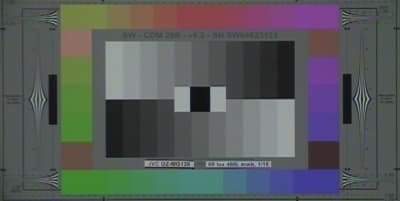
JVC provides a great option for shutter speed control, including the option to drop the shutter below 1/60th. At 1/30th, the performance did improve a little bit, but we didn’t see a lot of difference at 60 lux. When the light dropped to 15 lux, the shutter speed did come in handy. At 1/30th, we saw an improvement, though the noise was almost impenetrable. At 1/15th, the overall brightness looked good, but the noise, combined with motion blur, made the image unusable. In the end, it seems that 15 lux is too dark for the GZ-MG130 no matter what you do.


The camcorder produced 50 IRE at 28 lux – a very poor showing indeed. At 60 lux, Imatest imaging software found the image to produce a noise percentage of 0.967%, a color error of 12.6, and a saturation of 69.37 (meaning that it was -30.63% undersaturated).
Stabilization* (2.1)*
We tested the MG130’s DIS system with our custom built camcorder shake emulator. The shake emulator varies in different motion settings and can be tailored to match real life movement.
Speed 1 measures the camcorder’s DIS effectiveness while standing still, and speed 2 is the equivalent to the shake of a moving vehicle. The shake distance is calculated by comparing the difference between footage shot with the DIS on and with the DID off. At speed 1, the camcorder displayed a 33% shake reduction, and at speed 2, it only produced a 13% improvement.
Wide Angle* (10.8)*
We measure the field of view of camcorders in 16:9 mode. The zoom is set to its widest angle, image stabilization is turned off, and we view the full video frame on an external monitor derive a field of view measurement. The GZ-MG130's maximum field of view was 54 degrees.
Format
Compression* (4.0)*
The MG130 compresses video to the MPEG-2 format with dual-channel Dolby Digital audio on the HDD drive or an SD card. There are four recording quality settings that differ in variable data transfer rates. The premium setting, Ultra, has a Variable Bit Rate (VBR) of 8.5 Mbps, Fine transfers at 5.5 Mbps, Normal has a VBR of 4.2, and finally the lowest rung on the ladder, Eco, has a 1.5 Mbps VBR. While all JVC HDD camcorders top out at 8.5 Mbps, MiniDV has a fixed 25 Mbps data transfer rate in any quality setting. The MG130 is equipped with JVC’s new Gigabrid Engine image processor, which incorporates 6 digital noise reduction systems to reportedly improve the S/N ratio by roughly 3db over past models. Judging by the video, the system actually seems to work. The noise was low in decent lighting.
Video can be copied directly to a computer via a USB 2.0 connection, however, footage appears as .MOD files. You can manually change the file extension to .MPG to view the footage, but audio will not accompany the file.
Digital stills can be saved to a SD card or HDD drive with a maximum resolution of 640 x 480 in Fine and Standard mode.
Media* (7.0)*
This year, JVC tinkered with the hybrid design and added SD/SDHC card slots on all of their consumer Everio camcorders. The MG130 records video and stills to a 30GB HDD drive or a SD/SDHC card. The hard drive can hold up to 7 hours and 10 minutes of video footage in Ultra mode, 10 hours and 40 minutes in Fine mode, 14 hours and 10 minutes in Normal mode, and 37 hours and 30 minutes in Eco mode.
The HDD can serve as an external hard drive and store files for quick transfer when connected to a PC via the supplied high speed USB 2.0 cable. In addition, the HDD features a Floating Suspension system that dampens vibrations through polymer shock absorbers.
SD and SDHC cards are widely recognized and can be classified as high capacity flash media. These stamp-sized chips are highly portable and compress at the same rate as HDD and DVD camcorders.
Editing* (5.0)
*Non-linear editing programs for the MPEG-2 format are limited, but the MG130 comes supplied with Power Producer 3 NE and Power Director 5 NE Express. Power Producer 3 NE offers easy authoring of video clips to DVD in any order right from a USB connected camcorder. This program is highly user-friendly and allows for the simple creation of a DVD via transferring footage from the camcorder directly to a disc.
Power Director 5 NE Express provides you with a respectable array of non-linear editing features, enabling title creation, effects, and mixing stills with videos. You can also convert a variety of file formats including DV-AVI, Windows AVI, MPEG-1 and MPEG-2, WMV, and RealVideo.
Auto / Manual Controls
Picture & Manual Control
Automatic Control (4.0)
The GZ-MG130 is outfitted with automatic controls that are in line with other camcorders in its price range. The other auto controls for exposure, gain, and shutter speed work generally well in bright even lighting but falter in the situations that are challenging for any camcorder’s electronic brain.
In high- and low-contrast situations, the GZ-MG130 attempt to come up with a "best guess" for how to set the various image parameters based on the information in the frame. When the subject is backlit, it will likely appear underexposed – but BLC offers a quick fix. In other lighting scenarios, you’ll need to make use of the AE modes such as Snow, Spotlight, Sports mode, Twilight mode. Each of these modes adjusts the camcorder’s overall calibration to deal with a given lighting situation better than straight auto mode. Snow overexposes the entire frame so that a relatively dark subject is not underexposed, for example. If you are not one to make use of manual controls, these AE modes will help you to record a better looking picture when auto adjustments are not up to the task.
Overall Manual Control (4.85)
The Everio line has always been well-supplied with manual controls relative to most other consumer camcorders. All the essentials are there when the camcorder is in manual mode, including focus, shutter speed, white balance, exposure, and an auto gain shutoff options (though no manual gain level control). The controls are easy to access thanks to the on-screen joystick interface and rank as one of the highpoints of the camcorder, along with its 30GB HDD.
When we first encountered JVC’s LCD-mounted joystick, we were skeptical after growing accustomed to Panasonic’s rear-mounted joysticks. After trying them out, we came around because it feels quite natural to make selections on the screen with a controller immediately adjacent. Pressing the Function button, underneath the joystick brings up the manual control menu, including options for focus, brightness, shutter speed, and white balance. Program AE modes are accessed by tapping the joystick left, and NightAlive, video light, and BLC are also enabled via the joystick. The limitations of joystick controllers for making manual control adjustments should be mentioned here. While they are perfectly serviceable for step-based adjustments, like shutter speed, they are seriously lacking for manual focus. In fact, only rotary-based controls like dials – or best of all rings – offer the finesse needed to focus quickly and accurately.
The well-rounded palette of manual (and auto) controls on the MG130, morphed with an efficient menu interface is a pinnacle of this camcorder’s existence. Other characteristics such as video quality and construction are nothing to celebrate. It’s like throwing the priciest off-road tires you can find on a 1989 Geo Tracker: they’ll give you great control, but what really matters is under the hood.
*
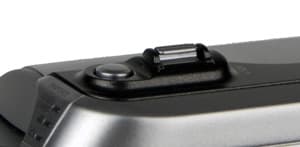
Zoom (6.0)*
JVC’s GZ-MG130 has a rocking lever-style zoom controller, on the top back end of the body. This is the zoom design we prefer because it offers the best combination of ergonomics and subtlety of control. For a while, Sony has been the champ in terms of refinement of rocking zoom levers because theirs are a little larger than most, and just plain feel smooth. The lever on the GZ-MG130 comes close, and you’ll find that it’s perfectly positioned under your index finger for hand-held operation – as long as you’re not endowed with gargantuan mitts. If you are, you’ll find more than the zoom lever on this pint-sized camcorder to be undersized. For the rest of us, the zoom offers good control over speed throughout its variable range.
Zoom Power Ratio (34.0)
For a time last year, JVC occupied the top spot for consumer camcorder optical zoom power before being unseated by Sony’s now 40x optical zooms on some of their entry-level models. This year’s JVC GZ-MG130 has an optical zoom at a modestly higher 34x, made possible by the small 1/6" sensor that’s standard on lower-end models. More expensive camcorders with larger sensors sport much lower optical zoom powers because the entire optical mechanism would need to be enlarged to muster the same power found on a 1/6" camcorder. Given a choice, we’ll always choose a larger imager – but 30x-plus zooms do come in handy if you’re a birding enthusiast or surveillance specialist.
There is also a digital zoom function that maxes out at 800x or can be capped at 68x (double the optical zoom power). Bear in mind that digital zooms enlarge the pixels available at the optical zoom maximum rather than the image itself, and thus result in a precipitous loss of resolution as soon as you enter digital territory. The ability to cap the digital zoom at 68x is a useful quality control mechanism that ensures that you’ll never record pixels at more than double their normal size. Better yet, forget about digital zoom, and move closer to your subject to maintain the best image quality at all times.
Focus (4.0)
It’s unusual to find a good manual focus control on a consumer camcorder – especially an entry-level one like the GZ-MG130. However, in all fairness, the joystick-based focus interface on this camcorder is good in comparison to what you’ll find on other low-end camcorders. Sony’s touch screen manual focus interface is the poorest of all, requiring you to tap buttons on the screen to make your adjustments. Needless to say, those buttons obscure the very image you’re trying to bring into focus. The left-facing touchpad on the Hitachi DZ-HS300A is another example of a poorly designed manual focus control, lacking the convenient location of the JVC’s joystick. That places JVC’s joystick focus controllers at the top of the bottom of the heap, (along with Canons and Panasonics that also use joysticks).
Here’s how the JVC’s manual focus works. After pressing the Function button on the LCD frame, a menu appears with Focus as the first option. After selecting this option, focus indicators appear on-screen in the form of a mountain icon at left, and a person icon at right. Pressing the joystick left, towards the mountain moves the focal plane further away, while pressing right towards the person icon moves the focal plane closer. After you’ve locked in focus manually, pressing the center of the joystick returns you to recording mode. Engaging manual focus control is fast, which is a plus during a shoot. The joystick itself works, but it does not allow you to moderate the speed of the adjustment, as with a dial or ring controller. You’re either moving through the focal range or you’re not, so we’ve found the best way to make fine adjustments with a joystick is by using small taps as you approach the focal plane.
Exposure & Aperture (6.0)
The JVC GZ-MG130 offers exposure adjustment in the form of exposure compensation in unspecified EV steps on a -6 to +6 range. While there is no independent iris adjustment, it is possible to make changes only to the lens aperture by disabling gain and setting shutter speed manually. To adjust exposure, select the Adjust Brightness option from the Function menu. When the exposure adjustment is engaged, a display appears on-screen showing your current manual exposure setting. Pressing the joystick left lowers the exposure, and pressing right raises the exposure.
While Panasonics do allow you to control iris in actual f-stops, the JVC approximates independent aperture control by allowing you to disable gain, set shutter speed, and then adjust brightness.
Shutter Speed (6.8)
As with other image controls, manual shutter speed adjustments are accessed via the JVC GZ-MG130’s Function menu where the Shutter Speed option is third from the top, below the Focus and Adjust Brightness options. After selecting Shutter Speed, an indicator appears on screen representing the current shutter speed setting. Pressing left lowers the shutter speed, and pressing right raises the shutter speed on a range of 1/2 second to 1/4000 of a second. The option to drop below 1/60 via manual adjustment is relatively rare, and Canon is the only other manufacturer to implement sub-1/60 settings even on entry-level camcorders. Even Panasonic – king of the manual control hill – only offers automatic sub-1/60 shutter speeds in low-light AE modes. The ability to set shutter speed manually below 1/60 is one of the attributes that differentiates the GZ-MG130 from most of the competition.
White Balance (5.75)
The GZ-MG130 offers a limited number of white balance presets: Auto, Halogen, Cloud, and Fine (for shooting outdoors under fair skies), and Manual. The white balance presets are the fourth option in the Function menu, below the Shutter Speed option. Setting a manual white balance is a straightforward operation. The manual white balance setting is activated by pressing the center of the joystick until the standard icon begins to flash. When the white balance icon stops blinking, the setting is locked in and you can either make further adjustments or resume shooting.
During manual setting, the white balance display occupies only a small portion of the screen, making it possible to see the results live. We found that we almost always preferred the manual white balance color to the presets, in part due to the oversaturation JVC has built into this camcorder.
Gain (1.0)
The JVC GZ-MG130 does not include independent manual control over gain, and Panasonic is the only manufacturer to offer this as a standard feature on its consumer camcorder line. However, JVC does allow you disable automatic gain as a means of controlling video quality. To disable/enable automatic gain, press the Menu button and navigate to the Image submenu. The image gain option is called Gain Up, and the only options available are on and off. If you want to ensure that you are always capturing the best quality video in low light, including most indoor shooting, you should consider leaving Gain Up disabled. In those cases where you absolutely cannot achieve an acceptable exposure without gain, you can always turn it on.
Other Manual Controls (0.0)
There are no other manual controls on the JVC GZ-MG130.
Still Features
Still Features* (3.5)*
If you are planning on purchasing a camcorder that touts well-balanced hybrid functionality, the MG130 will not fit within your search criteria. The camcorder’s maximum still image size is 640 x 480, whether recorded to the hard drive or SD card in either quality mode—Fine or Standard. The MG130’s SDHC/SD memory card slot is located on the bottom of the camcorder, which is not great for recording stills while the camcorder is attached to a tripod. In addition, JVC does not include a SD card with the MG130. The 30GB hard drive can hold up to 9999 still images in either quality mode, but at Internet-grade quality and size.
There is no flash on the MG130, so you’re left with the onboard LED light, which in no way emulates the effect of a flash and will leave your stills uneven and spotty. All manual controls are available in still mode including exposure, shutter speed, gain, etc., in addition to all automatic controls. The MG130 is PictBridge/DPOF supportive. PictBridge allows for direct printing from the camcorder when used with a compatible printer that is connected via a USB cable. DPOF (Digital Print Order Format) organizes stills for easier printing.
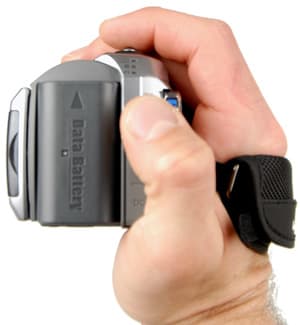
*The still photo shutter button is well-placed on top of the body, just under the forefinger.
That's about the best thing we can find for still features. *
Still Performance* (6.8)*
The JVC GZ-MG130 did not produce stellar looking still photos. With a resolution limited to 640 x 480, you’re not likely to use them beyond web photos, but even that could be done much better with super-cheap dedicated still camera (even most disposables). We did find some settings to improve image quality. Rather than leave it in auto, lowering the exposure down two notches (-0.70EV) produced a better image with less color bleed.
We test still performance by shooting a Gretag McBeth Color Checker chart and running those stills through Imatest imaging software. At a setting of -0.70EV, the GZ-MG130 produced a color error or 8.87, a noise percentage of 0.68%, and a saturation of 87.33.
Still Resolution* (2.43)
*Still resolution is testing by shooting an Applied Image ISO 12233 resolution chart and running those stills through Imatest imaging software. The best still resolution came by a manual reduction of the exposure to -1.0EV. In this setting, we found a horizontal resolution of 427.1, with a 1.23% black clipping and 12.6% oversharpening. The vertical resolution was 351.0, with a 1.31% black clipping and 16.5% oversharpening. The oversharpening was heavy and evident to the eye. Both this and the still performance test above indicate that when shooting stills, you’d be advised to lower the exposure.
Handling and Use
Ease of Use* (5.75)*
For a camcorder that is geared toward point-and-shooters, the MG130 has the potential to pollute its LCD display with unidentified looming icons. Yes, the MG130 is compact, easy to transport, and stripped of advanced ports. The LCD-mounted joystick is a joy to navigate with. The camcorder only has two modes: video and camera that are selected via the mode dial. In order to play back footage, you just press the select/play/record button in the LCD cavity. Yet it appears that JVC managed to make the MG130 a little too convenient.
Most point-and-shooters will be grasping the LCD panel while they are shooting, which means one inadvertent strike on the joystick could alter the backlight compensation, shutter speed, or activate the video light. The icons representing each action are so vague, including a daunting owl that stares ominously at you. This is in manual mode, though. The majority of MG130 owners will never even touch the auto/manual button and will run for the hills if it is accidentally shifted into manual mode. In that sense, yes the MG130 is a snap to use but only in full auto mode.
Handling* (5.0)*
The GZ-MG130 handles quite well, despite a construction that feels a bit second-rate. Assuming you can put aesthetics aside, the controls are well-placed, easy to use, and logically designed to keep the time you spend making adjustments to a minimum. In addition, the camcorder rests comfortably in your hand. It’s not big enough to list to the side, and the wide hand strap keeps pressure dispersed. You should only have problems with the general layout of the GZ-MG130 if you’ve got large hands and/or meaty fingers, in which case your fingers could overshoot the zoom lever, while the miniaturized controls may feel too dainty.
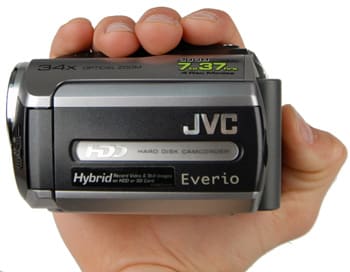
Ever the innovator, JVC’s now widely emulated Data Battery feature is back, providing detailed information on battery life and HDD capacity at the touch of a button. The joystick on the LCD frame is another design innovation we like as it places the control and menu interface front and center, right next to the screen. The Function button just below the joystick keeps access to manual controls like white balance and shutter speed quicker than on most consumer camcorders, while more arcane options are left to the Admin menu. This arrangement compares favorably with Sony’s touch screen menus that are dauntingly deep and detailed, and Panasonic’s joystick-based system, which can be tough for newbies to master.
While we like the handling of this and other JVCs (the HD7 is a much bigger version that handles even better), there is, of course video performance to consider. That is an area in which the GZ-MG130 struggles, so consider your options with care.
Menu* (5.25)*
The GZ-MG130 divides options between the main Admin menu, the Function menu, and an AE mode list. This divided menu strategy is shared by Panasonic and Canon, though each manufacturer takes a somewhat different approach. Sony is the lone company to stick with a single touch screen menu and control interface. JVC’s approach is a good one, in that it keeps those options most useful during a shoot quickly accessible, reserving the expansive Admin menu for setup options that you’ll use rarely if ever.
The manual control action takes place in the Function menu, accessed with ease by pressing the Func. button on the LCD frame. There, you’ll find Focus, Adjust Brightness (exposure compensation), Shutter Speed, WB (white balance), Effect (Sepia, Monotone, Classic Film, and Strobe), and Tele Macro. While we don’t love the joystick controller for all manual controls, especially focus, you can reach them all in a matter of seconds. That speed can make the difference between getting the shot and missing it as you fumble your way through a menu.
The Program AE list is even easier to access. Tapping the joystick right brings up a wheel where you’ll find a healthy selection of AE modes, including Twilight, Spotlight, Sports, and Snow. Several other options are available via the joystick when the camcorder is in manual mode: up engages backlight compensation, left engages Night Alive, and down turns on the video light.
The main Administrative menu is accessed via the Menu button in the LCD cavity. This menu has a significant learning curve for beginners, one that we’ll chalk up to poor design. Rather than having a simple, text-based list of sub-menus that goes from top to bottom, each item is represented by an icon. Also, the list is designed to loop, so that when you get to the last item and push down on the joystick one more time, you end up back at the top. But if you’re not paying attention, each item looks brand new, giving the appearance that the list goes on forever and ever. In reality, there are only a few sub-menus, but it tricks the beginners every time.
The Administrative menu includes submenus for video and still camera setup, and options for everything from menu language to DIS (electronic image stabilization) on/off.
Portability* (7.0)*
This is the kind of camcorder you’d find in Munchkin Land. It’s about as big as a fist, yet it fails to pack a potent punch. The MG130 measures 66mm x 71mm x 110mm (2 5/8" x 2 13/16" x 4 3/8") and can fit in a small bag or large pocket. It’s also a paperweight, gingerly tipping the scale at 320g (.71 lbs.). The MG130 is guaranteed to be a hit amongst the most esoterically versed point-and-shooters with a battery endurance of 1 hour and 35 minutes in conjunction with 430 minutes of continuous hard drive capacity. Super! Now Dad can take the whole family to Collinsville, Illinois to record 7 hours of the world’s largest bottle of ketchup. There are no protruding parts on the MG130, as this camcorder is a cheap plastic brick of suburban temptation. Just make sure the lens cap is closed or you’ll see scratches over your treasured family moments of sharing and caring.
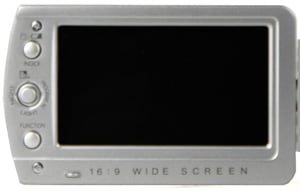
The LCD is the sole viewing device for the GZ-MG130. There is no viewfinder.
LCD and Viewfinder* (3.0)*
You won’t find a viewfinder on the puny MG130 because 9 out of 10 point-and-shooters will not know what a viewfinder is or how valuable it can be. LCD screens reign supreme in the land of home video, so JVC gave the MG130 a 2.7" 16:9 TFT active matrix system LCD (112,00 pixels) with a glossy screen. The LCD can rotate up to 270 degrees, but solarizes at the slightest angle. The hinge is also thin and flexible, but what would you expect on JVC’s cheapest Everio? To be honest, the LCD display looks better than the actual recorded footage – which
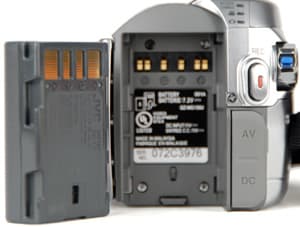
may prove a rude awakening to owners. The LCD panel is stacked with three buttons running vertically along the left side of the LCD screen: the index/battery meter, joystick, and function controls. We have to give props to JVC for their multi-faceted joystick. You can instantly access program AEs, backlight compensation, night shutter speed, and the video light with just one click.
Battery Life* (10.1)*
For the battery test, we set the camcorder to manual mode and let it record until the battery runs out. The total recording time of the MG130’s BN-VF808U battery pack was 1 hour, 40 minutes, and 41 seconds (100 minutes and 41 seconds). This is an improvement over last year’s Everio line and will treat you well on the road.
Audio / Playback / Connectivity
Audio* (3.0)*
The MG130 is equipped with a small built-in 2 channel Dolby Digital budget microphone that records 48kHz sound at 384 kbps in ultra fine and fine modes, 48kHz at 256 kbps in normal mode, and 48kHz at 128 kbps in economy mode. You’re going to want to record in ultra fine mode, seeing as how the sound quality of the MG130 is not even close to par. Luckily, the MG130 has no moving parts like a tape or DVD hatch, so in-camera sound is kept to a minimum. There is a wind cut feature that supposedly protects the sound from the harsh elements, but you won’t notice a huge difference in sound quality.
Playback* (2.25)*
Playing back footage on the MG130 is not very different from most HDD camcorders. By pressing the select/play/record button located in the LCD cavity, a menu of up to 12 thumbnails representing individual video clips is displayed. You can scroll through the thumbnails using the joystick and select a clip by pressing the center of the joystick. During playback, you can control the audio with the zoom toggle, which is an added bonus, compared to Sony’s labyrinth of touch screen menu selections. However, there is no playback control indication located in, around, or on the joystick. Therefore, you have to memorize the actions: left and right control the rewind and fast forward speeds, up starts the clip over, down selects the next clip, and center controls pause. The bummer is that you can only select the next clip, but not the previous one, requiring you to restart the menu and access the desired clip. The video mode function menu consists of: delete, protect, edited copy, change event reg. (for changing the registration of a file), effect, wipe/fader, playback playlist, edit playlist, playback MPG file, and playback normal file.
Playing back stills is a bit easier, as up and down rotate the image vertically and horizontally while left and right allow you to scroll forwards and backwards between images. The function menu here includes delete, protect, copy, move, DPOF (print setting), and effects.
Connectivity* (5.0)
*Ports are limited on the MG130, and they appear to be covered by thin plastic leftovers from the production floor. The USB terminal located in the front of the camcorder next to the built-in microphone is equipped with one of the cheapest port covers we’ve ever seen. You can pull it off the body just by breathing on it, so go easy on the tugging. The AV jack and DC connection in the back of the camcorder are housed by a similarly feeble cover with the same frail strip connecting it to the body. Weak. The DC jack is rectangular with a small tab at the top, which is more secure than most conventional round jacks. Finally, the SD card slot is located underneath the camcorder, forcing you to remove the MG130 from a tripod in order to swap cards. The SD card slot, however, is protected by a rubberized, hinged door that is much heftier than the aforementioned port covers.
Other Features
What’s in the Box?
The MG130 doesn’t give you a lot in terms of video quality, and inside the box is not really that different:
AP-V18U/14U AC Adapter
BN-VF808U Battery Pack
Audio/Video Cable
USB Cable
Shoulder Strap
CD-ROM
Remote Control Unit
Lithium Battery
The MG130 comes with a shoulder strap that will simply convert the camcorder into a heavy necklace – it’s just too small for the MG130. Based on the battery and hard dive recording time, it wouldn’t be necessary to stock up on an additional battery.
Other Features* (3.0)
**Video Light - *It’s small, it’s feeble, and it’s located off to the right side of the lens. The good news is that the LCD joystick can flip it on and off in one touch. However, you’d be better off using a penlight.
*Direct DVD Backup - *The MG130 can burn full sized DVDs using the Direct DVD function. The downside is that you need to purchase their optional Share Station in order to do so, which will set you back a hefty $199.95.
*Data Battery - *This handy little feature allows you to check the percentage of battery juice left by displaying a vertical bar meter. The remaining available recording time is also displayed, and this data can be checked even when the power is off.
*Gravity Sensor System (Drop Detection) - *When you’re out at the local parade and an elephant suddenly breaks free and rages toward your direction, there’s a high possibility you’re going to drop everything in your hands and run—camcorder included. JVC equipped the MG130 with a drop detection system that picks up on sudden changes in gravity and shuts the hard drive down during a fall before it hits the ground.
Comparisons / Conclusion
Comparison
JVC GZ-MG21
Last year’s version of the MG130 is almost identical in the looks department, but under the hood is a different story. Both camcorders sport the same 1/6" imagers, maximum still size of 640 x 480, bottom-loading SD card slot, and cheap, plastic design. However, the MG21 only has a 20GB hard drive while the MG130 boasts a 30GB hard drive. In addition, the MG21 has a 2.5" non-widescreen 4:3 aspect LCD screen that just oozes late 90’s. The only edge the MG21 has over the MG130 is an S-Video output. The real kicker is its price tag. For $100 more than the MG130, the MG21 is hardly a contender. Isn’t it disconcerting to know that there exists a worse camcorder than the MG130?
JVC GZ-*MG155
*The JVC GZ-MG155 ($599 MSRP) is the step-up model to the MG130, so the fact that both camcorders have almost identical dimensions and weight is not surprising. A 2.7" wide LCD screen is also shared, in addition to a 30GB hard drive. The MG155 pumps up the jam with a much larger 1.07MP imager, 1152 x 854 maximum still resolution, and supplied Everio docking station. It also has an S-Video output and a slightly smaller 32x optical zoom. What you need to decide is whether slightly better video, bigger still images, and a docking station is worth an extra $100.
Panasonic SDR-H20
The Panasonic SDR-H20 ($599 MSRP) does not look promising. Both camcorders have a 1/6" imager, 640 x 480 maximum still resolution, 2.7" wide LCD screen, and 30GB hard drive. Only the MG130 is $100 less than the H20. The MG130 even wins in the zoom department with a 34x optical vs. the H20’s 32x optical. However, Panasonic typically trumps everyone in manual controls, so they always manage a fan base. Also, the mid-level offerings from Panasonic in the last couple years have been a good value. We have no review for this model yet, so we’ll call it tied for now.
Sony DCR-SR42
It seems as though all entry-level hard drive camcorders share the same core elements within. The Sony DCR-SR42 ($599 MSRP) is no exception. Once again, both camcorders share the same 1/6" imager, 640 x 480 maximum still resolution, and 30GB hard drive. What the SR42 can brag about is its 40x optical zoom and H Series stamina battery that reportedly last up to 9 hours. What the SR42 can’t brag about is its 2.5" 4:3 aspect LCD screen. Wake up, Sony, it’s 2007. With a longer battery life and broader zoom, the SR42 does not seem to be worth an extra $100, so in this case, stick with the MG130. Sony will undoubtedly be easier to use, with better auto control responses, and – if their track record holds – a sharper image.
Who It’s For
Point-and-Shooters
The MG130 is for point-and-shooters. Hands down. Just watch the built-in demo video—it rivals the Magic Bullet infomercial.
Budget Consumers
If you can’t spend over $500 on a camcorder and want the convenience of a hard drive, you’re pretty much out of luck. Go for a MiniDV camcorder like the Canon Elura 100 (it’s still out there on the web). If you definitely have to have an HDD, save up an additional $100 and go for one of Panasonic’s new SDR-H20’s, which is believed to offer more manual controls, or look into Sony’s DCR-SR40.
Still Photo / Video Camera Hybrid
The maximum still resolution on the MG130 is 640 x 480. Lame. Other than that, you have a hard drive. That’s it.
Gadget Freaks
Gadget freaks need not apply. There is nothing enticing, enthralling, or exponentially exhilarating about the MG130.
Manual Control Freaks
The MG130 does sport a basic array of manual controls including white balance, shutter speed, exposure, and focus. That’s about as advanced as this point-and-shooter will get.
Pros / Serious Hobbyists
Pros and serious hobbyists will find various usages for the MG130, which include using it as a paperweight, piñata, or a kickball.
Conclusion
After watching the camcorder industry for as long as we have, you begin to see trends that play out from year to year. Sadly, 2007 is not the year for JVC’s entry-level Everios to make a break for greatness. Once again, video performance was only fair, with decent and even above-average color in bright light, but poor sensitivity in low light. Translated into day to day terms, this means you’ll capture decent looking video at Disneyland at noon, but relatively dark and grainy footage in the house. Virtually all shooting you’ll do in your house qualifies as low light – and if you do a lot of indoor shooting, this is something to keep in mind.
The JVC GZ-MG130 handles well, and it is laden with some bells and whistles you won’t find on every low-end HDD camcorder, including a video light, but stabilization – an important feature for hand-held shooters – was surprisingly bad. This camcorder’s biggest advantage over its competitors may be the manual control it offers, and the speedy joystick-based interface. If you want the convenience of HDD recording at a low price but don’t want to give up easy access to shutter speed and exposure, the GZ-MG130 is a camcorder to consider. If video performance and particularly low-light performance are your prime considerations, Sony’s HDD camcorders, including the as yet un-reviewed DCR-SR42 may be the better choice.
Specs and Ratings
{{manufacturer_specs_table}}{{raw_scores_table}}
Meet the tester

John Neely
Editor
John Neely is a valued contributor to the Reviewed.com family of sites.
Checking our work.
Our team is here to help you buy the best stuff and love what you own. Our writers, editors, and experts obsess over the products we cover to make sure you're confident and satisfied. Have a different opinion about something we recommend? Email us and we'll compare notes.
Shoot us an email